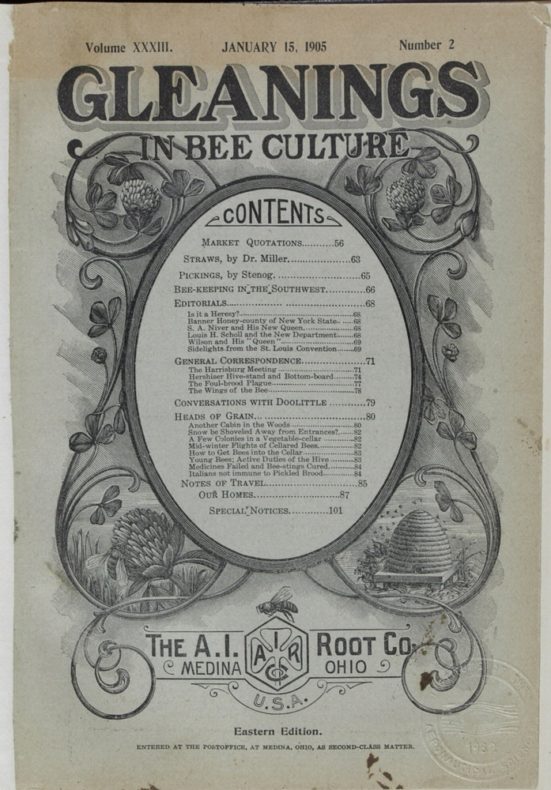If you were to think about it, where would you think the first eyewitness account of one of the Wright brothers’ flights would have appeared in print?
I’d guess the New York Times, maybe. A local newspaper in North Carolina or Ohio. Perhaps a venerable old science magazine like Scientific American.
Well, I would be wrong, because it actually appeared in a magazine called Gleanings in Bee Culture. In the January 1, 1905 issue, alongside articles like “Queens Mating More Than Once” and “How to Wash Out Kerosene Cans,” founder Amos Root wrote a very enthusiastic account of one of the brothers’ Ohio flights.

…it was my privilege, on the 20th day of September, 1904, to see the first successful trip of an airship, without a balloon to sustain it, that the world has ever made, that is, to turn the corners and come back to the starting-point. During all of these experiments they have kept so near the soft marshy ground that a fall would be no serious accident, either to the machine or its occupant. In fact, so carefully have they managed, that, during these years of experimenting, nothing has happened to do any serious damage to the machine nor to give the boys more than what might be called a severe scratch. I think great praise is due them along this very line. They have been prudent and cautious.
I learned this fun fact of publication history on a recent visit to the Smithsonian’s National Air and Space Museum. The 1903 Wright Flyer used to hang high in one of that museum’s big halls. For the centennial of their historic flight, it got its own gallery. I’ve been through there several times, but this was the first time I’d noticed the case in the corner with the bee magazine.
Amos Root was a bee enthusiast who founded a beekeeping supply company that still exists; it now sells fancy candles. He also started a magazine to share beekeeping insights. This was the dawn of the 20th century, and magazines weren’t really expected to focus. If you were a Midwestern businessman with a platform, you could write whatever you wanted, by golly.
According to David McCullough’s book The Wright Brothers, Root struck up a correspondence with the brothers early in 1904. It isn’t clear why they trusted him, but they did. They invited him to observe a flight in August of that year. He drove from his home in Medina, Ohio to their pasture near Dayton, and was amazed. In September they invited him again and let him write about what he saw.
The Wright brothers were very worried about their ideas being stolen, and they didn’t fly in public until 1908. Root offered his article to Scientific American, which declined to publish it. When the magazine did cover the Wright brothers the next year, it was with deep skepticism–surely, they wrote, a reporter would have found out about it by now, if this “flying” thing were real.
At the end of his eyewitness account, Root wrote:
When Columbus discovered America he did not know what the outcome would be, and no one at that time knew; and I doubt if the wildest enthusiast caught a glimpse of what really did come from his discovery. In a like manner these two brothers have probably not even a faint glimpse of what their discovery is going to bring to the children of men. No one living can give a guess of what is coming along this line, much better than any one living could conjecture the final outcome of Columbus’ experiment when he pushed off through the trackless waters.
It’s a little hard to even hold a time without airplanes in my head. When I was reading up on the pasture where they flew in Ohio, which became an airfield, I caught myself wondering whether it was already an airfield at the time.
Within 10 years a Wright plane was flown across the country, and look at us now. I flew from Detroit to Baltimore last week and not one beekeeper showed up to write about it.
Magazine cover image: National Air and Space Museum. You can read Root’s entire story on the Library of Congress website, which has reproductions of all of the pages, but I took the quotes from a website about the Wright brothers that helpfully provides the full text.